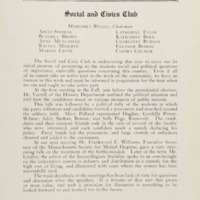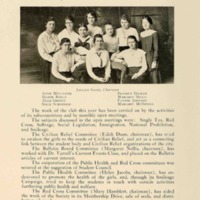A Secret Suffrage Club?
Helena Veronica O’Brien listed many extracurricular activities in her yearbook entry in 1915. They included three years on the basketball team and the glee club, service on the Endowment Fund Committee as a junior, and the position of Business Manager for the yearbook. O’Brien also noted that she was Vice President of an organization that appears rarely in college records: the Suffrage Club.
Was there a suffrage club at Simmons?
While other colleges had chapters of the College Equal Suffrage Society, Simmons students before O’Brien seem to have engaged with suffrage off-campus instead of on. Members of the college community had been active in various local suffrage organizations for years. Simmons students like Gladys Corthell were among the nearly 12,000 participants in Boston’s first suffrage parade on May 2, 1914. Perhaps that event -- and preparation for the next parade in October 1915 -- inspired a smalll group of students to form a group within the college. The club's President, Margaret "Dutch" Riegel '17, and Secretary, Elinor Reilly '18, mentioned the Suffrage Club in their yearbook entries when they graduated, but it was never officially noted otherwise. Despite the many advocates for women’s voting rights on the faculty, a Suffrage Club would have garnered the disapproval of other Simmons professors as well as the college president, Henry Lefavour. The climate on campus may have convinced -- or forced -- the Suffrage Club to stay off-stage.
The Social and Civic Club
Just over a year after the Suffrage Club's brief existence, students formed a new association with political engagement at its core. The Social and Civic Club sponsored multiple speakers every month, along with student discussions on “community betterment, politics, economics, and current events.” Their mission was to educate club members “so that while in College and after leaving, they may be able to take a more intelligent part in the activities of their community.”
The club’s scope and program was in essence preparation for citizenship, and a hospitable place for suffragists. But by avoiding mention of the still controversial idea of votes for women, the Social and Civic Club would have expanded its appeal to a spectrum of students. With a well organized leadership drawn from all classes (Freshmen, Sophomore, Junior, Senior, and graduate students), it clearly aimed to be a popular and highly visible club. And even anti-suffrage administrators and faculty at the college could hardly have opposed civic and community involvement by Simmons students.
During its first year, the Social and Civic Club organized a political rally on the college’s athletic fields, with students grouped by political party to cheer on their peers playing the parts of all four Presidential candidates: the incumbent Woodrow Wilson (Democrat), Charles Evans Hughes (Republican), Theodore Roosevelt (Progressive), and Allan Benson (Socialist). “Party bands led the procession and large crowds of onlookers cheered and added to the excitement,” club members reported in the 1917 yearbook.
At other club meetings, invited speakers addressed topics from socialism in industry, to the education of disabled children. The club’s officers were active in several other key student organizations, from the Menorah Society, Socialism Club, and Persimmons magazine (Adele Shohan) to the Simmons chapter of the YWCA (Rachel Meserve).
In the 1918-1919 academic year, the organization changed its name to simply the Civic League, and signalled a sharper focus on progressive reform in its official description: “to promote a greater interest among students in the conditions and problems of political, economic, educational, and social life.” Its president, Gertrude Barish, nurtured ties beyond campus, to World War I relief work, public health lobbying, advocacy for labor rights through the National Consumers League, and a continued focus on discussing socialism. The Civic League hoped to engage “the entire student body,” hosting biweekly open forums on lively, provocative topics.
The club continued in this form past the passage and ratification of the Nineteenth Amendment in 1920. In 1922-1923, it merged with the Current Events Club to become a new organization called the Student Forum.




